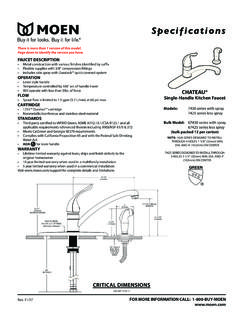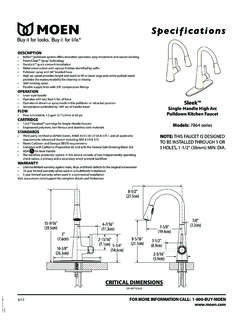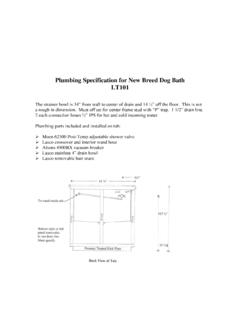Transcription of i r c c k C myths about the Clearing up Deming cycle and ...
1 In 50 Words Or Less In the 1950s, W. Edwards Deming brought the scientific method to in-dustry. Later, the method was called the plan-do-study-act (PDSA) cycle . Deming built the method from many problem-solv-ing theories, including Shewhart s specification, production and inspec-tion process. PDSA remains one of today s most popular problem-solving methods and continues to up myths about the Deming cycle and seeing how it keeps evolvingby Ronald D. moen and Clifford L. Norman Circling BackTHERE STILL SEEMS to be much confusion surrounding W. Edwards Deming s plan-do-study-act (PDSA) cycle . The misunderstandings can be summarized by three basic questions:1. How did Deming s PDSA cycle evolve?2. Did Deming create the plan-do-check-act (PDCA) cycle ?3. Are PDCA and PDSA related?Before answering these questions and Clearing up the misconceptions, it s important to review the PDSA cycle s foundation, which starts with the scien-tific method. November 2010 QP23basic quality Circling BackQP 1 shows the evolution of the scientific meth-od and the PDSA cycle , starting with Galileo Galilei in 1610, pragmatism in the early 1900s and the evolution of the PDCA and PDSA cycles through 1993.
2 The foundationGalileo, considered by many to be the father of modern science, made original contributions to the science of motion and strengths of materials by combining designed experiments and mathematics. Through his studies, conducting designed experi-ments became the cornerstone of science and the scientific Francis Bacon made his contribution to modern science as a philosopher who was concerned about how knowledge is developed. He believed knowledge generation must follow a planned structure. At the time, science depended on deductive logic to interpret nature. Bacon insisted that scientists should instead pro-ceed through inductive reasoning from observations to axiom to law. His contribution completed the inter-play between deductive and inductive logic that under-lies how we advance knowledge. Charles Peirce and William James were students at Harvard University in Cambridge, MA, in January 1872 when they formed a discussion group called the Meta-physical This group would forever be linked with the uniquely American philosophy called pragma-tism.
3 The group said the function of thought is to guide action and that truth is preeminently to be tested by the practical consequences of Dewey became a leading proponent of prag-matism, and his works influenced philosophy, educa-tion, religion, government and democracy around the James and Dewey s pragmatism could be sum-marized in one statement: People are the agents of their own destinies. Clarence I. Lewis, an American pragmatist also educated at Harvard, was heavily influenced by Peirce and James. Lewis set out three ideas in Mind and the World Order to further the pragmatists influence:31. A priori truth is definitive and offers criteria through which experience can be The application of concepts to any particular expe-rience is hypothetical, and the choice of conceptual system meets pragmatic The susceptibility of experience to conceptual in-terpretation requires no particular metaphysical as-sumption about the conformity of experience to the mind or its and DemingLewis book had enormous influence on Walter A.
4 Shewhart and Deming in bringing the scientific method to 20th century s Statistical Method From the Viewpoint of Quality Control, published in 1939, first introduced the concept of a straight-line, three-step scientific pro-cess of specification, production and He later revised this idea into a cyclical concept. Figure 2 contrasts the two views of Shewhart s idea of specifica-tion, production and inspection. These three steps must go in a circle instead of in Evolution of the scientific method and PDSA cycle / FIguRE 1 Father of modernscienceGalileo (1610)Inductive learningFrancis Bacon (1620)PragmatismCharles PeirceWilliam James (1872) How We ThinkJohn Dewey(1933)Integration ofpragmatismand Lewis (1929)Shewhart cycleWalter Shewhart (1939) Deming wheelW. Edwards Deming (1950)PDCAJ apanese QC(1951)PDCAK aoru Ishikawa TQC (1985)Shewhart cycleDeming (1986)PDSAD eming (1993) PDCA = plan-do-check-act TQC = total quality control PDSA = plan-do-study-act QC = quality control November 2010 QP25a straight line, as shown, Shewhart wrote.
5 It may be helpful to think of the three steps in the mass production process as steps in the scientific method. In this sense, specification, production and inspection correspond re-spectively to hypothesizing, carrying out an experiment and testing the hypothesis. The three steps constitute a dynamic scientific process of acquiring knowledge. 5 Shewhart s concept eventually evolved into what became known as the Shewhart cycle . Deming had a front-row seat for Shewhart s think-ing: At the age of 39, Deming edited a series of lec-tures Shewhart delivered to the Department of Agriculture into what eventually became the basis of Shewhart s 1939 built off Shewhart s cycle and modified the concept. He got the chance to present the new version of the cycle in 1950 during an eight-day seminar in Ja-pan sponsored by the Japanese Union of Scientists and Engineers (JUSE).6 In his new version of the cycle , Deming stressed the importance of constant interaction among the four steps of design, production, sales and research.
6 He em-phasized that these steps should be rotated constantly, with quality of product and service as the aim, as shown in Figure 3. This new version is referred to as the Dem-ing wheel, the Deming cycle or the Deming wheel evolvesAccording to Masaaki Imai, Japanese executives re-cast the Deming wheel presented in the 1950 JUSE seminars into the PDCA Table 1 shows Imai s description of the relationship between the Deming wheel and the PDCA did not provide details about which execu-tives reworked the wheel or how they translated the Deming wheel into the PDCA cycle . No one has ever claimed ownership of this revision or disputed Imai s resulting PDCA cycle , shown in Figure 4 (p. 26), shows the four-step cycle for problem solving. The cycle includes:1. Plan: Define a problem and hypothesize possible causes and Do: Implement a Check: Evaluate the qualityShewhart cycle 1939 / FIguRE 2 Shewhart straight-line processStep oneSpecificationStep twoProductionStep threeInspectionShewhart cyclical conceptProductionSpecificationInspection Deming wheel 1950 / FIguRE 31234 1.
7 Design the product (with appropriate tests).2. Make the product and test in the production line and in the Sell the Test the product in service and through market research. Find out what users think about it and why nonusers have not bought Deming wheel vs. the Japanese PDCA cycle / TAbLE 11. Design = planProduct design corresponds to the planning phase of Production = doProduction corresponds to doing. making or working on the product that was Sales = checkSales figures confirm whether the customer is Research = actIf a complaint is filed, it must be incorporated into the planning phase and action taken in the next round of efforts PDCA = plan-do-check-actQP Act: Return to the plan step if the results are unsat-isfactory, or standardize the solution if the results are PDCA cycle also emphasized the prevention of error recurrence by establishing standards and the on-going modification of those standards. Once again, others wanted to enhance and revise the cycle .
8 This time, it was Kaoru Ishikawa. He rede-fined the PDCA cycle to include more in the planning step: determining goals and targets, and formulating methods to reach those Figure 5 shows the PDCA cycle and incorporates Ishikawa s the do step, Ishikawa also included training and education to go along with implementation. Ishikawa said good control meant allowing standards to be re-vised constantly to reflect the voices of consumers and their complaints, as well as the requirements of the next process. The concept behind the term control (kanri) would be deployed throughout the PDCA cycle , with Ishikawa s updates and improvements, can be traced back to S. Mizuno of the Tokyo Institute of Technology in 1959. The seven basic tools (check sheet, histograms, Pareto chart, fishbone diagram, graphs, scatter diagrams and stratification) highlight the central principle of Japanese These tools together with the PDCA cycle and the quality control (QC) story for-mat became the foundation for improvement (kaizen) in Japan and are still being used cycle evolutionMore than 30 years after Deming first revised the Shewhart cycle , Deming again reintroduced it during four-day seminars he hosted in the He said the latest version had come directly from the 1950 version.
9 Any step may need the guidance of statistical methodology for economy, speed and protection from faulty conclusions from failure to test and measure the effects of interactions, Deming Figure 6 illus-trates the procedure to follow for improvement. Deming warned his audiences that the PDCA ver-sion is frequently inaccurate because the English word check means to hold back. Once again, Deming modified the Shewhart cycle in 1993 and called it the Shewhart cycle for Learning and Improvement the PDSA cycle , as shown in Figure Deming described it as a flow diagram for learning and improvement of a product or a vs. PDSAOver the years, Deming had strong beliefs about the PDCA cycle and clearly wanted to distinguish it from the PDSA cycle . At a roundtable discussion on product quality at the Government Accounting Office, Deming was asked how the QC circle (referring to PDCA) and the Deming circle related. They bear no relation to each other, Deming said.
10 The Deming circle is a quality control program. It is a plan for management. Four steps: Design it, make it, sell it, then test it in service. Repeat the four steps, over and over, redesign it, make it, etc. Maybe you could say that the Deming circle is for management, and the QC circle is for a group of people that work on faults encountered at the local level. 13On Nov. 17, 1990, Deming wrote a letter to Ronald Japanese PDCA cycle 1951 / FIguRE 4 Japanese PDCA cycle 1985 / FIguRE 5 PlanDoCheckActEngage ineducation ofreaching theeffects PDCA = plan-do-check-act PDCA = plan-do-check-actNovember 2010 QP27D. moen to comment on the manuscript for Improv-ing Quality Through Planned Experimentation, coauthored by moen , Thomas R. Nolan and Lloyd P. Be sure to call it PDSA, not the corruption PDCA, Deming wrote in the response to a letter he received in 1991, Deming commented about a chart labeled plan-do-check-act. What you propose is not the Deming cycle , he wrote in the letter.





